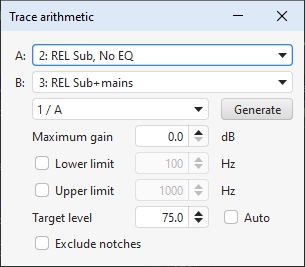The Trace Arithmetic tool allows the chosen pair of traces to be
added, subtracted, multiplied, divided, coherently (aka vector) averaged or merged.
Either of the traces may also be inverted (magnitude, phase or both). Division and
inversion can be restricted to a frequency range with the response left unchanged outside
that range. If both the chosen traces have impulse responses,
the result will also have an impulse response, however the sample rates must be either the
same or related by an integer. For example, traces at 44.1kHz and 11.025kHz can be combined
via an arithmetic operation, the result will have the higher of the two rates. This allows
operations on band limited measurements which may have been decimated to a lower sample rate.

If the traces have incompatible sample rates, or neither has an impulse response,
the result will not have an impulse response, but it may have both magnitude and phase
data if both the traces it was applied to had magnitude and phase data, otherwise the
result will only have magnitude data and the traces will be treated as incoherent.
If one trace has an impulse response and the other does not the result will have an
impulse response. This could be used to merge a cal file response with an IR or apply
a target response adjustment to an IR.
The frequency span of the result of an arithmetic operation will usually be from the lowest
start frequency to the highest end frequency of the traces operated on. Some operations have
the option of limiting the result to the overlapping range of the measurements, that is controlled
by the Result spans combined frequency range control. Outside their
frequency range traces are treated as being zero valued, with the exception of the divisor
in a division operation which is treated as being unity outside its range. If the
measurements actually have significant levels outside the measurement range the zero
setting will generate oscillations in frequency and time domains, for best results use
traces that span the full frequency range.
Trace arithmetic notes
- For meaningful results measurements that have impulse responses or phase data should
be properly time aligned before they are combined. Being properly time aligned may mean
having a common timing reference or may mean removing time delays, it depends on the
operation and what you are trying to achieve. An exception is the Merge operation,
for which REW will automatically align both magnitude and phase at the merge frequency,
adjusting the trace B time delay as required for the phase match. The amounts of the
adjustments are shown in the notes of the newly generated measurement.
- The currently applied impulse response window settings are used for each trace. The
result uses the same window settings as trace A unless the operation was Merge B to A,
in which case the window settings for trace B (the low frequency portion) are used,
or for division and inversion, which use windows that span the entire resulting impulse
response as the result is typically not causal. The
window reference time for the result will be at the peak of the result IR. The
left window width will be increased if necessary so that it is at least twice the span
from the start of the result IR to its peak to avoid truncation artefacts in the result.
Any frequency-dependent settings are excluded, applying an FDW to the result would amount
to applying the window twice, as it is already applied to the data used to produce the result.
- The result of arithmetic on measurements that have compatible impulse responses is
smoothed using the measurement A smoothing, unsmoothed data is used during the calculations.
Other measurements use whatever smoothing they already had applied during the calculations
and the result is treated as unsmoothed (or 1/48 octave smoothed if data is 96 PPO).
- The division operations have an optional maximum gain parameter parameter which limits the boost
which occurs when the divisor becomes very small (or zero), such as where the divisor
has notches in its response, and so produces a more stable and manageable result. Division
may also be constrained to operate within a desired frequency span, with an upper and/or
lower frequency limit. Outside those limits the behaviour depends on whether gain limiting
is selected. If the gain limit is being used REW treats the operation as an attempt to produce
a band limited correction filter and division reverts to unity gain, blended over
a 1 octave span centred on the limit frequency. If the gain limit is not being used
division reverts to the numerator, offset to align with the result within the band limit.
- The inversion operations have an optional maximum gain parameter which limits the boost which occurs
when the response being inverted becomes very small (or zero), such as where there are notches,
and so produces a more stable and manageable result. Inversion may be constrained to operate
within a desired frequency span, with an upper and/or lower frequency limit. Outside those
limits inversion reverts to unity gain, blended over a 1 octave span centred on the limit
frequency. Inversion also provides a target level for the inversion to use, or a check box
to set the target automatically based on the average level of the measurement, and an option
to exclude parts of the response that look like notches from the inversion. The 1/|A| and
1/|B| operations produce a linear phase result.

